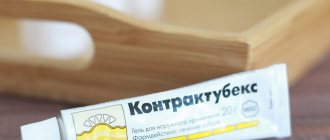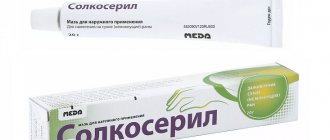Gel Venolife: composition
Venolife gel is a medicinal product for external use, containing three active components (heparin, dexpanthenol, troxerutin), and has 5 actions at once in the fight against varicose veins:
- reduction of swelling due to improved local blood flow and microcirculation;
- analgesic effect (reduction of pain caused by the inflammatory process);
- reduction of inflammation;
- restoration of damaged skin;
- strengthening capillaries.
The drug contains 3 active substances:
- Heparin. A direct-acting anticoagulant that has an anti-inflammatory effect, promotes tissue regeneration, prevents thrombus formation and improves local blood flow.
- Dexpanthenol. Provitamin B5 – turns into pantothenic acid in the skin, improving metabolic processes. Promotes regeneration of damaged tissues and improves heparin absorption.
- Troxerutin. Helps restore the firmness and elasticity of blood vessels, improving microcirculation and reducing venous stagnation. Has anti-edematous and anti-inflammatory effects.
Venolife 40g gel
INSTRUCTIONS
on the use of a medicinal product for medical use
VENOLIF®
Registration number
: LS-001377
Trade patent name:
Venolife ®
International nonproprietary name or generic name:
Heparin sodium + Dexpanthenol + Troxerutin
Dosage form:
gel for external use
Compound
100 g of gel contain:
Active substances:
troxerutin in terms of 100% substance - 2 g, sodium heparin in terms of dry substance - 0.25 g (30000ME), dexaptenol in terms of 100% substance 5 g;
Excipients
: phenylethanol 1 g
,
propylene glycol 10 g, carbomer 940 or 980
0.8 g trometamol 0.4 g, purified water up to 100 g.
Description
Transparent or almost transparent gel of light yellow color with a specific odor.
Pharmacotherapeutic group:
direct acting anticoagulant for local use + other drugs.
ATX Code:
C05BA53
Pharmacological
properties
Venolife® gel is a combined preparation for external use, the pharmacological properties of which are determined by the action of the substances included in its composition.
Heparin is a direct acting anticoagulant. natural anticoagulant factor
body - has an anti-inflammatory effect. promotes the regeneration of connective tissue by inhibiting the activity of hyaluronidase; prevents thrombus formation, activates fibrinolytic properties of blood; improves local blood flow.
Dexpanthenol - provitamin B5 - is converted in the skin into pantothenic acid, which is part of coenzyme A, which plays an important role in the processes of acetylation and oxidation; by improving metabolic processes, dexpanthenol promotes the regeneration of damaged tissues; improves the absorption of heparin.
Troxerutin is an angioprotective agent; has P-vitamin activity, in particular, it reduces vascular tissue permeability and capillary fragility, helps normalize microcirculation and tissue trophism, reduces congestion in the veins and paravenous tissues, and has an anti-edematous and anti-inflammatory effect.
In addition, due to the presence of the antiseptic preservative phenylethyl alcohol, the drug has a bactericidal and fungicidal effect, helping to prevent infection of the wound surface. The composition of the gel base provides the drug with moderate hyperosmolar properties.
Pharmacokinetics
When applied topically, the active substances are quickly absorbed by the skin. Heparin accumulates in the upper layers and actively binds to skin proteins, dexpanthenol penetrates all layers of the skin and turns into pantothenic acid, troxerutin is found in the dermis after 30 minutes, and in subcutaneous fatty tissue after 2-5 hours.
Indications for use
—
edema-pain syndrome and microcirculatory-trophic disorders caused by
venous insufficiency of the lower extremities (varicose veins, acute and
chronic thrombophlebitis, postthrombophlebitis syndrome, chronic lymphostasis);
- soft tissue injuries (hematomas, dislocations, sprains);
- to accelerate granulation and epithelization of trophic ulcers in the regeneration phase (in the absence of pronounced exudation).
Contraindications
- hypersensitivity to the components of the drug,
- open infected wounds or wounds with heavy exudation at the site of application,
- children under 1 year of age.
Use during pregnancy and lactation
Venolife® can be used during pregnancy and lactation.
Directions for use and doses
Externally. Apply a thin layer to the affected area 2-3 times a day, evenly distributing over the surface of the skin with light rubbing movements until completely absorbed. The course of treatment is 2-3 weeks. The need for further treatment is determined by the attending physician, based on the severity of the pathological process and the results of clinical tests. If the disease relapses, the course of treatment can be carried out 2-3 times a year.
For trophic ulcers with weak exudation, before using the drug, the wound surface is cleaned of exudate and necrotic tissue, if necessary, washed with a solution of hydrogen peroxide 3%, nitrofural 1:5000 or chlorhexidine bigluconate 0.05% and dried. The gel is applied in a uniform thin layer so that the entire affected surface is covered with the drug, and a sterile gauze bandage is applied. The dressings are changed once a day. With the open method of treatment, the drug is applied 1-2 times a day. The duration of treatment is determined by the dynamics of epithelization.
Side effect
Local manifestations of allergic reactions (skin rash, itching) are possible.
Overdose
Overdose is unlikely due to the low systemic absorption of the gel components.
Interaction with other drugs
No interaction of the drug with other drugs has been identified.
special instructions
Venolife ® is not intended for use in ophthalmology, intravaginal or
rectal administration.
Release form
Gel for external use, 30 g or 40 g in an aluminum tube. Each tube along with
instructions for use are placed in a cardboard pack.
Storage conditions
At a temperature of 15 to 25 ° C, out of the reach of children.
Best before date
2 years. The drug cannot be used after the expiration date indicated on the package.
Conditions for dispensing from pharmacies
Over the counter.
Manufacturer
JSC “Chemical-Pharmaceutical Plant “AKRIKHIN”, Russia.
142450, Moscow region, Staraya Kupavna, st. Kirova, 29.
Tel/fax
Indications and contraindications
Venolife gel must be used according to the instructions for use in the following cases:
- To reduce swelling, pain in the legs, eliminate microcirculatory-trophic disorders that are caused by venous insufficiency (varicose veins, thrombophlebitis, chronic lymphostasis).
- Treatment of soft tissue injuries, including hematomas and sprains.
- To accelerate the healing of trophic ulcers.
Venolife gel can be used during pregnancy and lactation, as well as in children over 1 year of age.
The drug should not be used in the following cases:
- In case of individual sensitivity to the components included in the composition;
- In the presence of wounds with exudate or signs of infection.
Venolife 100g gel for external use
pharmachologic effect
Direct acting anticoagulant for local use + other drugs.
Composition and release form Venolife 100g gel for external use
Gel – 100 g:
- active ingredients: troxerutin in terms of 100% substance - 2 g, sodium heparin in terms of dry substance - 0.25 g (30000 IU), dexpanthenol in terms of 100% substance - 5 g;
- excipients: phenylethanol 1 g, propylene glycol 10 g, carbomer 940 or 980 0.8 g, trometamol 0.4 g, purified water up to 100 g.
40 or 100 g in an aluminum tube. Each tube, along with instructions for use, comes in a cardboard box.
Description of the dosage form
Transparent or almost transparent gel of light yellow color with a specific odor.
Directions for use and doses
Externally. Apply a thin layer to the affected area 2-3 times a day, evenly distributing over the surface of the skin with light rubbing movements until completely absorbed. The course of treatment is 2-3 weeks. The need for further treatment is determined by the attending physician, based on the severity of the pathological process and the results of clinical tests.
If the disease relapses, the course of treatment can be carried out 2-3 times a year.
For trophic ulcers with weak exudation, before using the drug, the wound surface is cleaned of exudate and necrotic tissue, if necessary, washed with a solution of hydrogen peroxide 3%, nitrofural 1:5000 or chlorhexidine bigluconate 0.05% and dried. The gel is applied in a uniform thin layer so that the entire affected surface is covered with the drug, and a sterile gauze bandage is applied. The dressings are changed once a day. With the open method of treatment, the drug is applied 1-2 times a day. The duration of treatment is determined by the dynamics of epithelization.
Pharmacodynamics
Venolife® gel is a combined preparation for external use, the pharmacological properties of which are determined by the action of the substances included in its composition.
Heparin is a direct anticoagulant, a natural anticoagulant of the body, has an anti-inflammatory effect, promotes the regeneration of connective tissue by inhibiting the activity of hyaluronidase; prevents thrombus formation, activates fibrinolytic properties of blood; improves local blood flow. Dexpanthenol - provitamin B5 - is converted in the skin into pantothenic acid, which is part of coenzyme A, which plays an important role in the processes of acetylation and oxidation; by improving metabolic processes, dexpanthenol promotes the regeneration of damaged tissues; improves the absorption of heparin.
Troxerutin is an angioprotective agent; has P-vitamin activity (reduces vascular tissue permeability and capillary fragility), helps normalize microcirculation and tissue trophism, reduces congestion in the veins and paravenous tissues, has an antiexudative and anti-inflammatory effect.
Pharmacokinetics
When applied topically, the active substances are quickly absorbed by the skin. Heparin accumulates in the upper layers and actively binds to skin proteins, dexpanthenol penetrates all layers of the skin and turns into pantothenic acid, troxerutin is found in the dermis after 30 minutes, and in subcutaneous fatty tissue after 2-5 hours.
Indications for use Venolife 100g gel for external use
Edema-pain syndrome and microcirculatory-trophic disorders caused by venous insufficiency of the lower extremities (varicose veins, acute and chronic thrombophlebitis, post-thrombophlebitis syndrome, chronic lymphostasis).
Soft tissue injuries (hematomas, dislocations, sprains).
To accelerate granulation and epithelization of trophic ulcers in the regeneration phase (in the absence of pronounced exudation).
Contraindications
Hypersensitivity to the components of the drug, open infected wounds or wounds with heavy exudation at the site of application, children under 1 year of age.
Application of Venolife 100g gel for external use during pregnancy and breastfeeding
Venolife® can be used during pregnancy and lactation.
special instructions
Venolife® is not intended for use in ophthalmology, for intravaginal or rectal administration.
Overdose
Overdose is unlikely due to the low systemic absorption of the gel components.
Side effects of Venolife 100g gel for external use
Local manifestations of allergic reactions (skin rash, itching) are possible.
Drug interactions
No interaction of the drug with other drugs has been identified.

